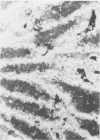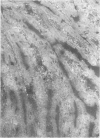Abstract
The colonizing and proliferating abilities of enterotoxigenic acapsular or K99- mutants of bovine enteropathogenic Escherichia coli strains were compared with those of their capsulated and K99+ parent strains in the small intestine of infected colostrum-fed calves. Calves infected with the enteropathogenic E. coli parent strains developed profuse diarrhea and severe dehydration. None of the calves which received the acapsular mutant developed diarrhea and one of three calves inoculated with the K99- enterotoxigenic mutant developed moderate diarrhea. The parent enteropathogenic E. coli strains colonized the middle and lower small intestine; in these areas a layer of specific immunofluorescence against the enteropathogenic E. coli covered most villi and 80% of the organisms were associated with the intestinal wall. The acapsular mutant strain failed to colonize the small intestine and fluorescent bacteria were not observed in any area of the small intestine. The K99- mutant proliferated to a lesser extent than did the K99+ parent strain in all areas of the small intestine but moderately colonized the lower small intestine where fluorescent bacteria were observed to cover parts of the intestinal villi.
Full text
PDF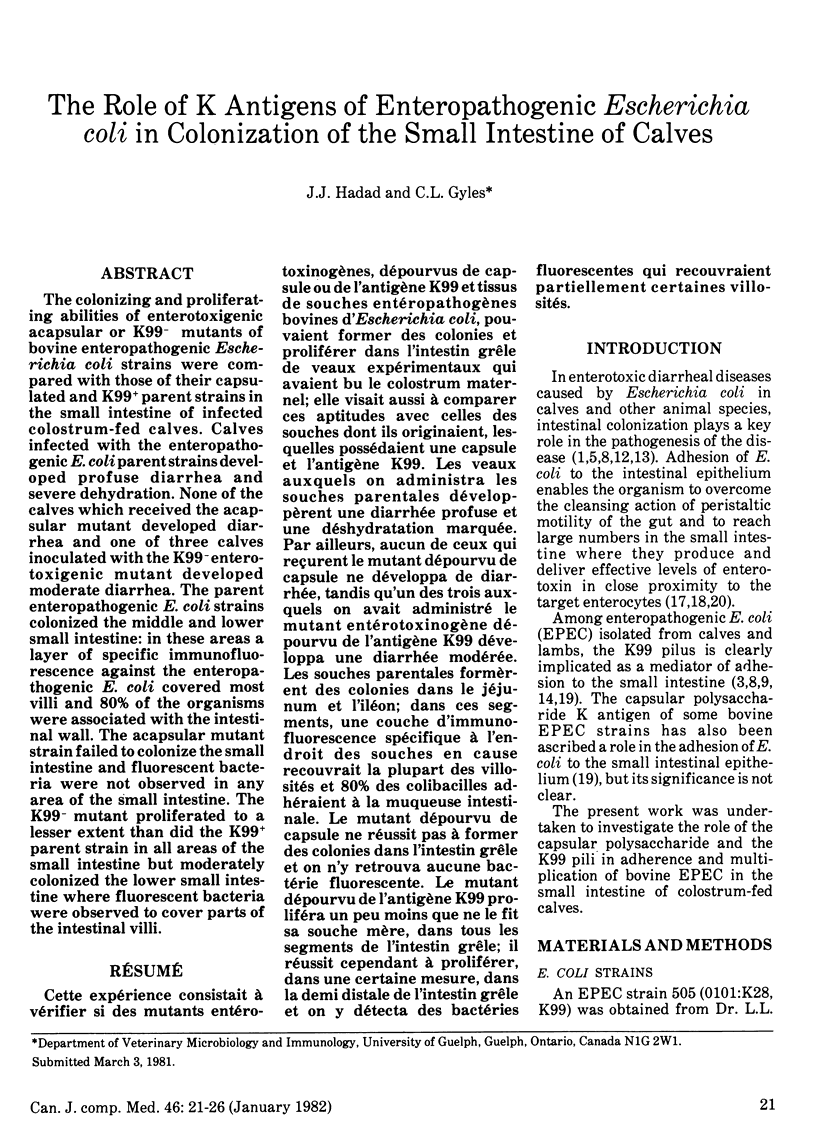
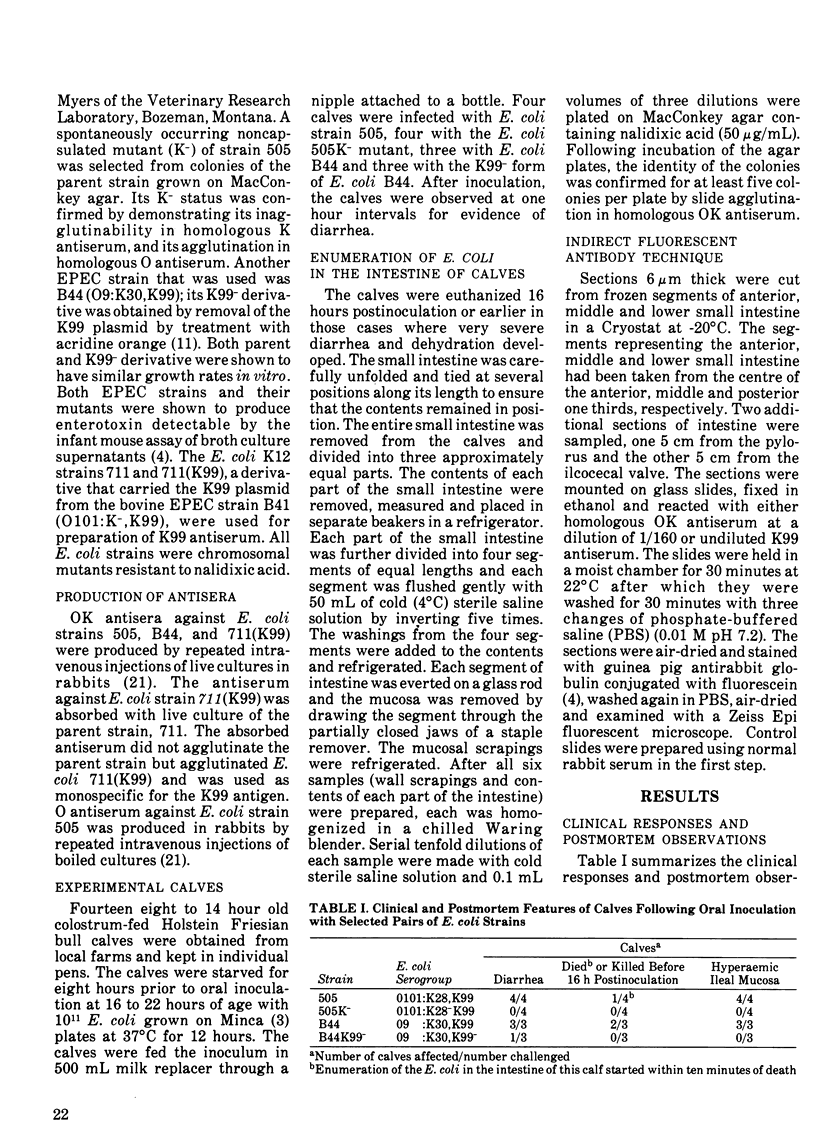
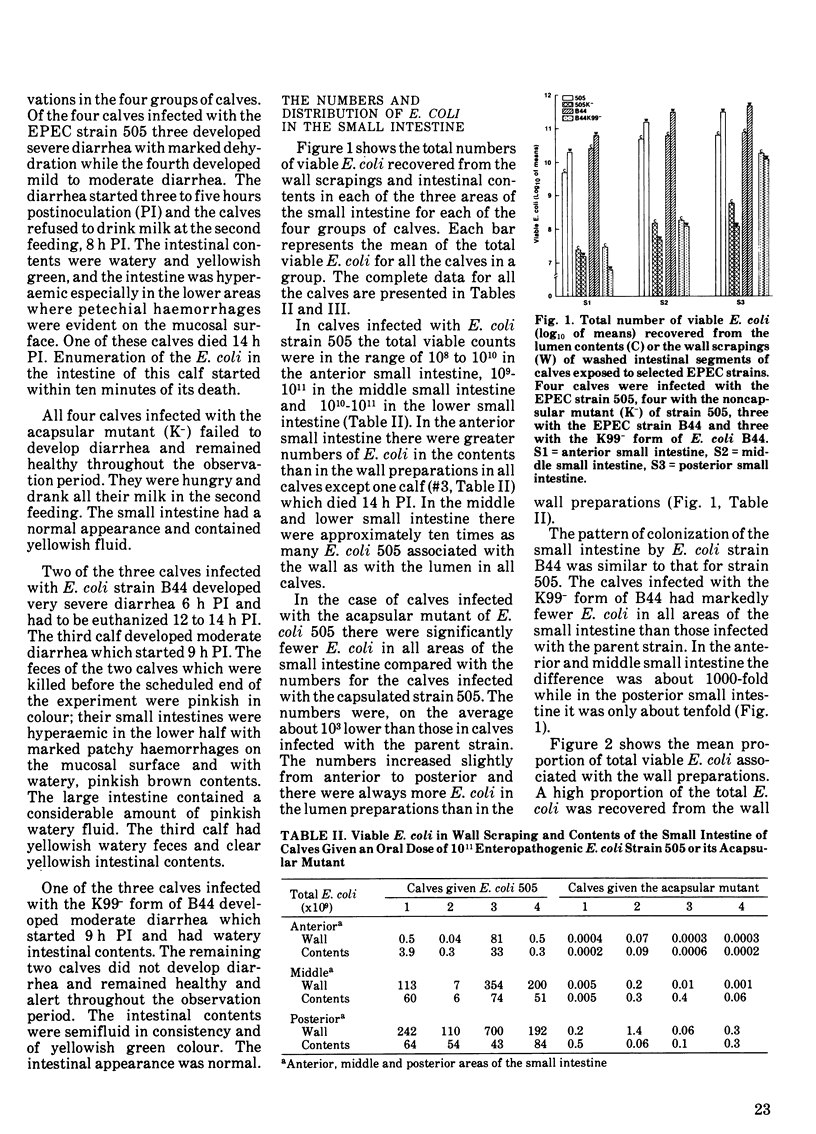
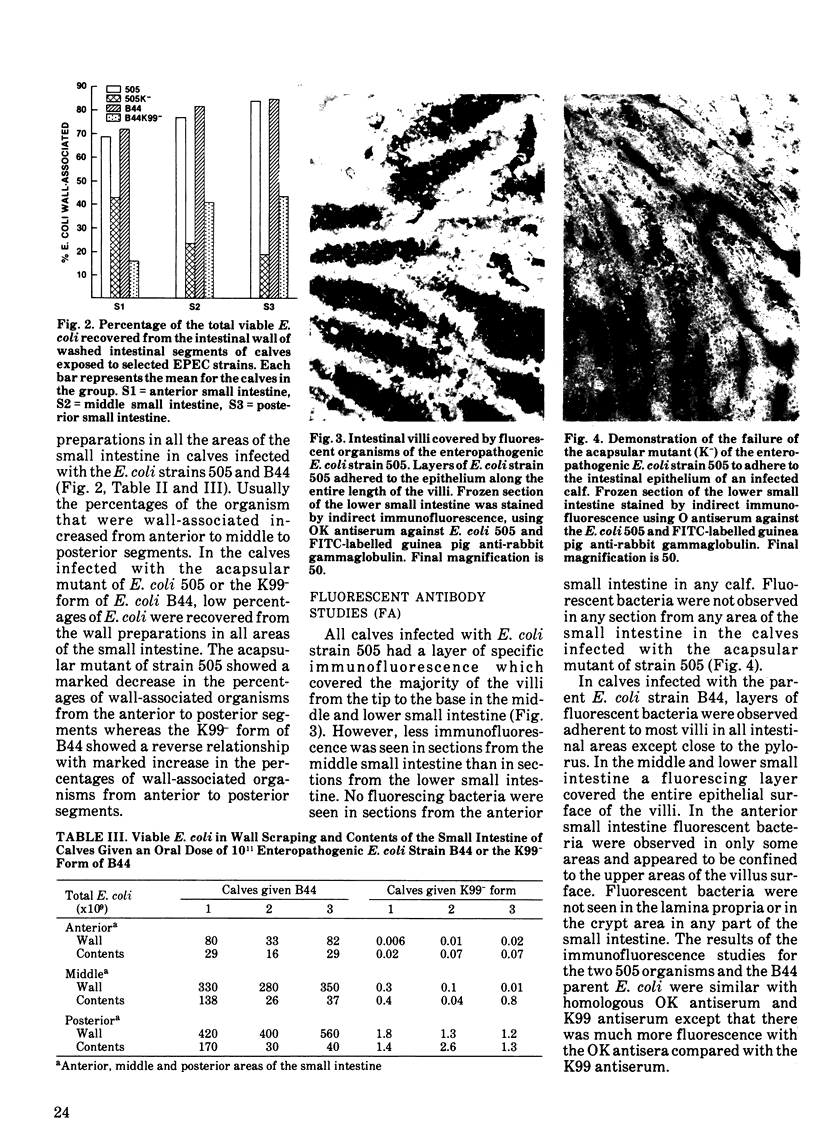
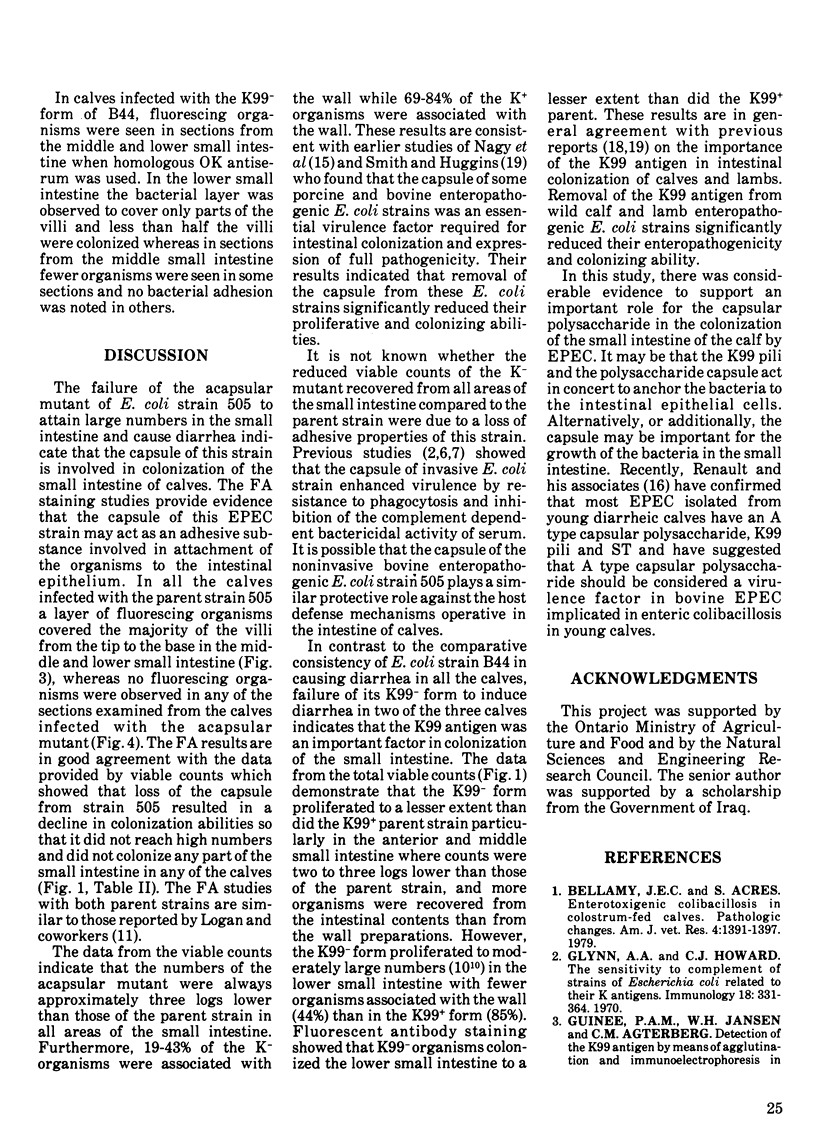
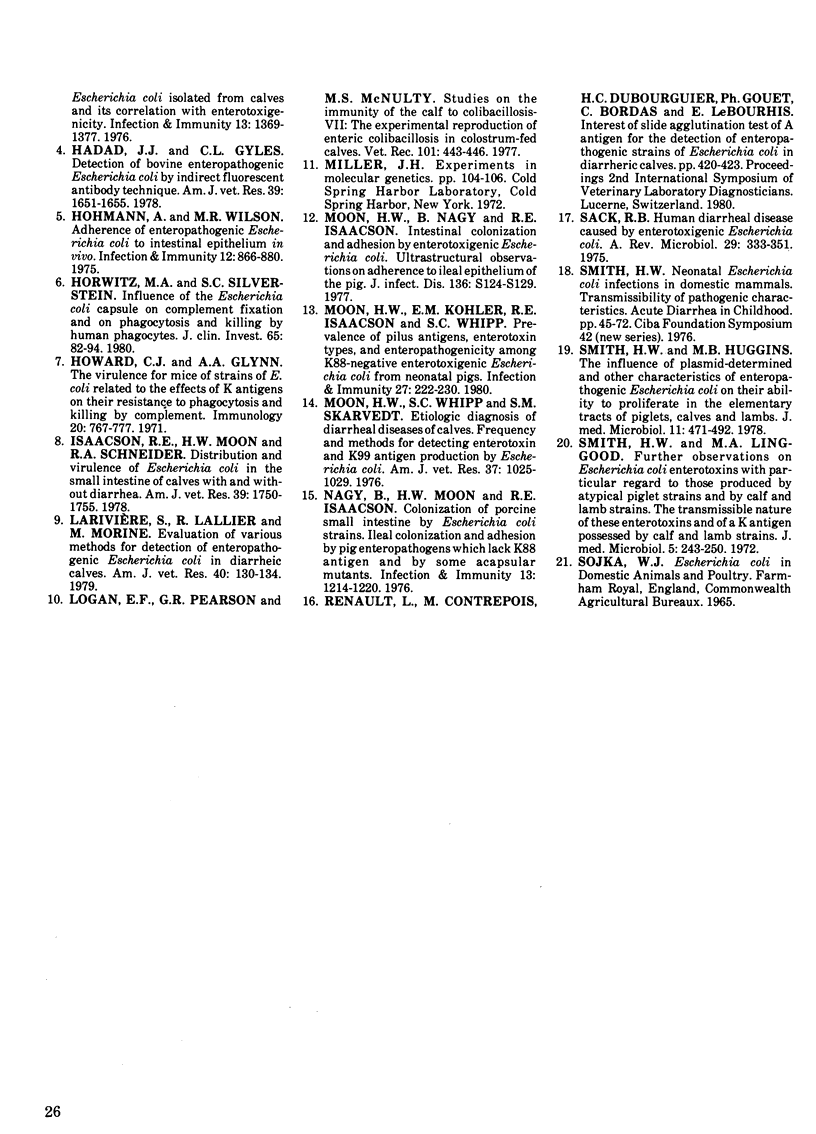
Images in this article
Selected References
These references are in PubMed. This may not be the complete list of references from this article.
- Bellamy J. E., Acres S. D. Enterotoxigenic colibacillosis in colostrum-fed calves: pathologic changes. Am J Vet Res. 1979 Oct;40(10):1391–1397. [PubMed] [Google Scholar]
- Glynn A. A., Howard C. J. The sensitivity to complement of strains of Escherichia coli related to their K antigens. Immunology. 1970 Mar;18(3):331–346. [PMC free article] [PubMed] [Google Scholar]
- Guinée P. A., Jansen W. H., Agterberg C. M. Detection of the K99 antigen by means of agglutination and immunoelectrophoresis in Escherichia coli isolates from calves and its correlation with entertoxigenicity. Infect Immun. 1976 May;13(5):1369–1377. doi: 10.1128/iai.13.5.1369-1377.1976. [DOI] [PMC free article] [PubMed] [Google Scholar]
- Hadad J. J., Gyles C. L. Detection of bovine enteropathogenic Escherichia coli by indirect fluorescent antibody technique. Am J Vet Res. 1978 Oct;39(10):1651–1655. [PubMed] [Google Scholar]
- Hohmann A., Wilson M. R. Adherence of enteropathogenic Escherichia coli to intestinal epithelium in vivo. Infect Immun. 1975 Oct;12(4):866–880. doi: 10.1128/iai.12.4.866-880.1975. [DOI] [PMC free article] [PubMed] [Google Scholar]
- Horwitz M. A., Silverstein S. C. Influence of the Escherichia coli capsule on complement fixation and on phagocytosis and killing by human phagocytes. J Clin Invest. 1980 Jan;65(1):82–94. doi: 10.1172/JCI109663. [DOI] [PMC free article] [PubMed] [Google Scholar]
- Howard C. J., Glynn A. A. The virulence for mice of strains of Escherichia coli related to the effects of K antigens on their resistance to phagocytosis and killing by complement. Immunology. 1971 May;20(5):767–777. [PMC free article] [PubMed] [Google Scholar]
- Isaacson R. E., Moon H. W., Schneider R. A. Distribution and virulence of Escherichia coli in the small intestines of calves with and without diarrhea. Am J Vet Res. 1978 Nov;39(11):1750–1755. [PubMed] [Google Scholar]
- Larivière S., Lallier R., Morin M. Evaluation of various methods for the detection of enteropathogenic Escherichia coli in diarrheic calves. Am J Vet Res. 1979 Jan;40(1):130–134. [PubMed] [Google Scholar]
- Logan E. F., Pearson G. R., McNulty M. S. Studies on the immunity of the calf to colibacillosis--VII: the experimental reproduction of enteric colibacillosis in colostrum-fed calves. Vet Rec. 1977 Nov 26;101(22):443–446. doi: 10.1136/vr.101.22.443. [DOI] [PubMed] [Google Scholar]
- Moon H. W., Kohler E. M., Schneider R. A., Whipp S. C. Prevalence of pilus antigens, enterotoxin types, and enteropathogenicity among K88-negative enterotoxigenic Escherichia coli from neonatal pigs. Infect Immun. 1980 Jan;27(1):222–230. doi: 10.1128/iai.27.1.222-230.1980. [DOI] [PMC free article] [PubMed] [Google Scholar]
- Moon H. W., Whipp S. C., Skartvedt S. M. Etiologic diagnosis of diarrheal disease of calves: frequency and methods for detecting enterotoxin and K99 antigen production by Escherichia cola. Am J Vet Res. 1976 Sep;37(9):1025–1029. [PubMed] [Google Scholar]
- Nagy B., Moon H. W., Isaacson R. E. Colonization of porcine small intestine by Escherichia coli: ileal colonization and adhesion by pig enteropathogens that lack K88 antigen and by some acapsular mutants. Infect Immun. 1976 Apr;13(4):1214–1220. doi: 10.1128/iai.13.4.1214-1220.1976. [DOI] [PMC free article] [PubMed] [Google Scholar]
- Sack R. B. Human diarrheal disease caused by enterotoxigenic Escherichia coli. Annu Rev Microbiol. 1975;29:333–353. doi: 10.1146/annurev.mi.29.100175.002001. [DOI] [PubMed] [Google Scholar]
- Smith H. W., Huggins M. B. The influence of plasmid-determined and other characteristics of enteropathogenic Escherichia coli on their ability to proliferate in the alimentary tracts of piglets, calves and lambs. J Med Microbiol. 1978 Nov;11(4):471–492. doi: 10.1099/00222615-11-4-471. [DOI] [PubMed] [Google Scholar]
- Smith H. W., Linggood M. A. Further observations on Escherichia coli enterotoxins with particular regard to those produced by atypical piglet strains and by calf and lamb strains: the transmissible nature of these enterotoxins and of a K antigen possessed by calf and lamb strains. J Med Microbiol. 1972 May;5(2):243–250. doi: 10.1099/00222615-5-2-243. [DOI] [PubMed] [Google Scholar]



